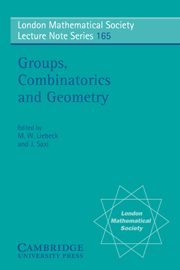Book contents
- Frontmatter
- Contents
- Authors' Addresses
- Introduction
- Part 1 Sporadic groups
- 1 Uniqueness of sporadic groups
- 2 The study of J4 via the theory of uniqueness systems
- 3 Y555 and all that
- 4 Hyperbolic reflections for the Bimonster and 3Fi24
- 5 A geometric characterization of the Monster
- 6 Constructing the Monster
- Part 2 Moonshine
- Part 3 Local and geometric methods in group theory
- Part 4 Geometries and related groups
- Part 5 Finite and algebraic groups of Lie type
- Part 6 Finite permutation groups
- Part 7 Further aspects of simple groups
- Part 8 Related topics
5 - A geometric characterization of the Monster
Published online by Cambridge University Press: 07 September 2010
- Frontmatter
- Contents
- Authors' Addresses
- Introduction
- Part 1 Sporadic groups
- 1 Uniqueness of sporadic groups
- 2 The study of J4 via the theory of uniqueness systems
- 3 Y555 and all that
- 4 Hyperbolic reflections for the Bimonster and 3Fi24
- 5 A geometric characterization of the Monster
- 6 Constructing the Monster
- Part 2 Moonshine
- Part 3 Local and geometric methods in group theory
- Part 4 Geometries and related groups
- Part 5 Finite and algebraic groups of Lie type
- Part 6 Finite permutation groups
- Part 7 Further aspects of simple groups
- Part 8 Related topics
Summary
We present a characterization of the Monster sporadic simple group in terms of its 2-local parabolic geometry.
Introduction
We consider the largest sporadic simple group which is called the Fischer-Griess Monster or the Friendly Giant and is denoted by F1, M or FG. Here we follow the monster terminology and the notation F1.
Let G(F1) be the minimal 2-local parabolic geometry of F1 constructed in. Then G(F1) has rank 5 and belongs to a string diagram all whose nonempty edges except one are projective planes of order 2 and one terminal edge is the triple cover of the generalized quadrangle of order (2,2), related to the nonsplit extension 3·S6. The geometries having diagrams of this shape are called T-geometries.
The geometry G(F1) can be described as follows. The group H ≅ F1 contains an elementary abelian subgroup E of order 25 such that NH(E)/CH(E) ≅ L5(2). Let E1 < E2 < … < E5 = E be a chain of subgroups of E, where ∣Ei∣ = 2i, 1 ≤ i ≤ 5. Then the elements of type i in G(F1) are the subgroups of H which are conjugate to Ei; two elements are incident if one of the subgroups contains the other.
Let {α1, α2, …, α5} be a maximal flag in G(F1) and Hi be the stabilizer of αi in H. Then Hi are called the maximal parabolic subgroups associated with the action of H on G(F1). Without loss of generality we can assume that αi = Ei (clearly Hi = NH(Ei) in this case), 1 ≤ i ≤ 5. Below we present a diagram of stabilizers where under the node of type i the structure of Hi is indicated.
- Type
- Chapter
- Information
- Groups, Combinatorics and Geometry , pp. 46 - 62Publisher: Cambridge University PressPrint publication year: 1992
- 8
- Cited by



